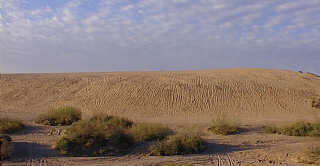 |
The area known as the East Heights was formed by debris washing off the Sandia Mountains onto more level ground. These sloping out wash plains are called alluvial fans because, when viewed from above, they tend to be fan-shaped. The apex, or converging points, of these fans are the mouths of large arroyos and canyons of the Sandias. (See illustration in Section 1, page 9.)
When the runoff from these steep canyons hits the more level ground of the Plains, much gravel, sand, and silt is dropped. The streams then form a delta-like series of arroyos which meander and redistribute themselves all over the fan, depositing more rock material. Arroyos sometimes carry savage floodwaters which can destroy homes and buildings in their path. The soils deposited here vary from coarse to fine silt, and are not uniform. Generally, they tend to be coarse near the mountains and in the arroyos.
Precipitation is between 8 and 14 inches (20 to 35 cm.) a year. Generally, there is greater precipitation at high elevations and more snowfall in those parts. The Heights does not experience the temperature extremes of the Valley.
 |
Sand Dunes |
Short grass is the natural vegetation of the Heights. Prairie grass is approximately 35 percent (by weight) of the total vegetation. About 15 percent of the ground is covered by vegetation. Important grasses are black grama, sand dropseed, galleta, threeawn, blue grama, alkali sacaton, and fluffgrass. Shrubs and wildflowers such as broom snakeweed (a sign of disturbance), blazing star, prickly pear, purple nightshade, aster, winterfat, and mallow are also found. More woody plants are found in arroyos. Among these plants are apache plume, skunk bush, and fourwing saltbush. When this plant community is disturbed, there will be an increase in tumbleweed (Russian thistle), broom snakeweed, sand dropseed, fluffgrass, and prickly pear. Much of the Heights is developed and in many areas, only the arroyos are left in a semi-natural state. A nearby vacant lot, however, may have some of these species.
Animal life consists mainly of small mammals, birds, reptiles, and insects. The most common animals are gophers, mice, kangaroo rats, ground squirrels, horned larks, sparrows, sparrow and cooper hawks, lizards, horned lizards, snakes, grasshoppers, praying mantises, carrion beetles, ants, and spiders.
(Up to Section IV, Back to A Valley School, On to A Mountain School)